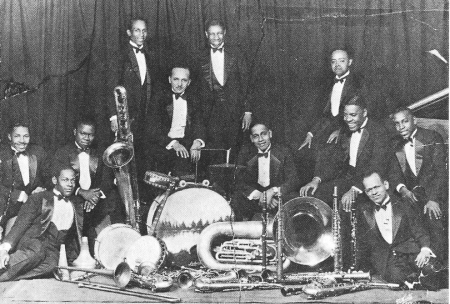But was Goodman the King of Swing as he is generally designated? What about this Fletcher Henderson? Who was this guy and what role does he play in the birth of swing? He was born to a middleclass black family in Cuthbert, Georgia in 1897 where classical music was the order of the day. He studied classical piano in which he excelled. Among wealthy black families, especially in the South, the playing of blues, jazz and rags was looked down on if not outright forbidden. This disdain for black folk music was even more pronounced in wealthier southern blacks who had transplanted themselves in the North and sought to appear cultured and wanted nothing to do with music that might make them appear to be sharecroppers and field hands in disguise. They shared this disdain in common with religious blacks who pronounced all forms of black folk music (with the exception of hymns and gospel) to be “the devil’s music.”
Henderson was sent to Atlanta University where he studied chemistry and mathematics. He graduated with a degree in chemistry and went to New York looking a job in that line of work. Instead, he was forced to take a job working for a black-owned company called Pace-Handy Music Company where he demonstrated songs on the piano for $22.50 a week. Henderson’s musical talent and knowledge were so good that Harry Pace began using him to organize and run jazz recording sessions for the Black Swan label owned by Pace. Henderson, in addition to hiring the bands that recorded also often played with them and wrote their arrangements. Many musicians wanted him to form a band so they could quit their current gigs and play for him. He formed a cadre of sidemen for the recording sessions. When an opening at Club Alabam on West 54th Street advertised for a bandleader, his sidemen wanting steady work and weekend gigs pressured him to go. Up to then, Henderson had not made up his mind to pursue a musical career full time still toying with the idea of finding a job as a chemist. He auditioned, was accepted and the die was cast. A short time later, Henderson left Club Alabam to take a long-running gig at the Roseland which he converted into the most important jazz venue in the country during his decade-long stint there.
The orchestra played his dazzling, complex arrangements to great acclaim. Although considered staples now, the arrangements were unheard of in Henderson’s time. They required musicians of great talent and proficiency to execute the way Henderson envisioned. True to form, his band membership was a who’s who of the swing era—Lester Young, Chu Berry, Coleman Hawkins, Omer Simeon, Ben Webster, John Kirby, Russell Procope, Clarence Holiday (Billie’s father), Sid Catlett, Buster Bailey and Benny Carter on sax. These were arguably the greatest sax men in the business. His trumpet section boasted Red Allen, J. C. Higginbotham, Benny Morton, Tommy Ladnier, Roy Eldridge, Jimmy Harrison, Rex Stewart, Dickie Wells, Joe Smith and someone named Louis Armstrong. None of the other Harlem bandleaders as Ellington or Chick Webb could come close to that even though each had awesome talent in their respective orchestras. And just as Duke had his Billy Strayhorn to help out on composition and arrangement, Henderson had the great Don Redman.

Fletcher Henderson and orchestra. Henderson sits behind the drums. Seated on the floor at the left is Coleman Hawkins. Seated behind Hawkins next to the baritone sax is Louis Armstrong.
Don Redman was born in West Virginia in 1900 and was a child prodigy learning to play a variety of instruments and excelled on all of them. By the 1920s, he was touring with Billy Paige’s Broadway Syncopators as clarinetist and sax man. He was also the band’s arranger writing all their charts. When he came to New York, he met Henderson and the two hit it off and began a partnership. Indeed, without Redman, the Fletcher Henderson Orchestra might never have attained more acclaim than being a band that helped great up and coming talent cut their teeth before moving on to greater things—not that the band didn’t serve this function but it was so much more due to the perspicacity of its arrangements.

Don Redman
Originally, their arrangements were lackluster and derivative. Well played but not particularly noteworthy. But as time went on, Henderson and Redman began to get more daring and innovative realizing their arrangements were not up to snuff and re-recorded some of them the way they were now envisioning.
When Redman began to really hit his stride as an arranger he was commissioned by Paul Whiteman to write for his orchestra. Redman came up with “The Whiteman Stomp” which both Henderson’s and Whiteman’s bands recorded in 1928. Jazz historian Ted Gioia describes it thusly: “…Redman delves into the avant-garde, crafting a highly eccentric orchestration in which fragments of musical shrapnel take flight unpredictably, coalescing into an odd type of jazz, one built on disjunction and entropy. That same year, half a world away, physicist Werner Heisenberg was articulating his famous uncertainty principle, the foundation of quantum physics. Here Redman shows his allegiance to the same zeitgeist, espousing a jagged, pointillistic style in which all continuities are called into question.”
Fletcher Henderson - Whiteman Stomp - N.Y.C. 11.05.1927 - YouTube
A strange mixture of hot swing, avant-garde and corn jazz, some of the novelty effects on the piece are reminiscent of Spike Jones whose own recordings were still a few years away yet.